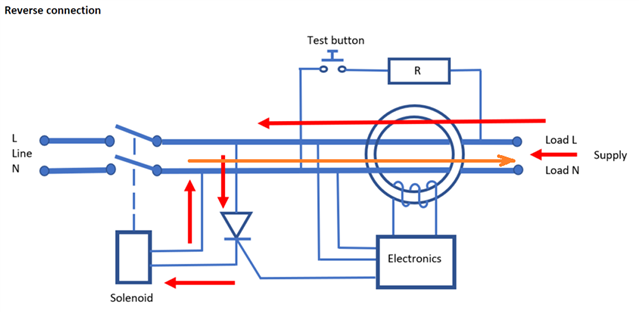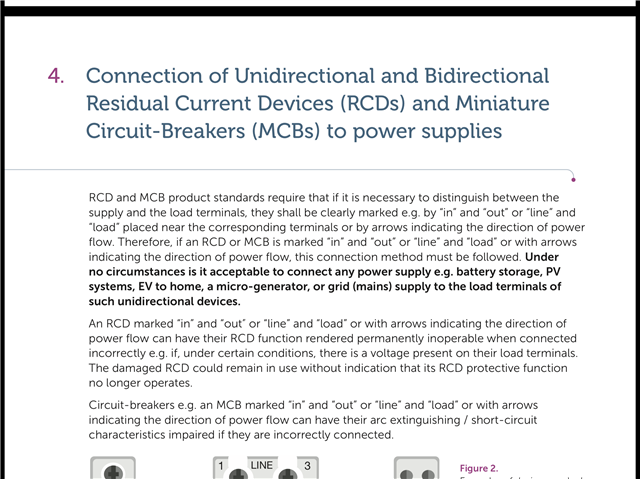I had an email this morning from the IET telling me that a Draft for Public Consultation has been published for Amendment 3 to BS 7671.
Details here electrical.theiet.org/.../
JP
I had an email this morning from the IET telling me that a Draft for Public Consultation has been published for Amendment 3 to BS 7671.
Details here electrical.theiet.org/.../
JP
When a residual current is detected by the current transformer, a signal is sent to the electronics from the secondary winding, which in turn opens the gate of the thyristor and allows current to flow to the solenoid. This causes the solenoid to operate resulting in the operation of the switching mechanism and opening of the contacts which interrupts the current flow.
The important thing here is that once a signal enters the thyristor gate and activates the device, it will continue to pass current until the voltage drops below a specific level. In the event of an earth fault or using the test button, the RCBO will trip but there will still be a voltage present on the load terminals from the PV inverter resulting in current flowing through the thyristor and the solenoid being activated for an extended length of time.
I've been pondering this - and I'm not sure I'm convinced now. If I recall correctly from by PE mag days, the thyristor will turn off as soon as the current through it drops to zero - and as RCDs operate on AC that's every half cycle. So it can only overheat if the electronics continue to trigger the gate, which should only happen if there's an imbalance in the toroid.- which now there can't be as the only load on the mechanism side of the open contacts is the RCD electronics etc themselves - and that current (if the diagram is correct) should be returning through the toroid.
e.g. adding the return current to the diagram (orange arrow) we get:

So at the moment I'm thinking that the electronics/thyristor/solenoid are in no more danger of overheating than they would be in normal service with the contacts closed - which hopefully is pretty negligible. Or I've missed something (again...).
- Andy.
closed
Yes it would normally interrupt at the next half cycle.
Also it's been tested for an inductive load fault at 0.7 pf so the thyristor will be able to handle substantial back EMF too.
However if you've got an inverter in a fault state that starts feeding DC, or a line-commutated inverter that depends on its load to get back to zero crossing then you might have a problem. A 1kVA line-communtated inverter would need to dump upto around 10J before it can zero cross.
That said, if an installation has a line-communtated inverter it would become apparent quite quickly that it's not compatible with the RCBO. Ultimately we're supposed press the T button regularly. My main worry with this ammendment is that it's going to trigger a lot of inappropriate C2s from people interpreting a lack of protection and therefore potentially dangerous when in reality the risk is in many circumstances there's still fault and overload protection so it would tend to be a C3.
I'm not sure how the proposed wording can be changed to address that - the GN2&GN6 are the place for that commentary. But we know very well that whenever there's a national departure of this kind there's a guarantee that people will over-react.
Having seen no end of incompetent board changes to address inappropriate C2s on plastic boards that ought to have been C3 - I'm sceptical. At the same time there's some very sensible points here which Graham Kenyon is rightly highlighting and I agree with him that they should be addressed.
It's very difficult to choose wording which is objective and there's nothing Graham and his colleagues on JPEL/64 can do about people willfully misusing the regs - they have to assume people are competent even though clearly not everyone is.
It's very difficult to choose wording which is objective and there's nothing Graham and his colleagues on JPEL/64 can do about people willfully misusing the regs - they have to assume people are competent even though clearly not everyone is.
Yes, but when you have BEAMA giving strongly worded advice;

Along with what looks like an emergency amendment to 7671 being rushed through with the only focus being on the bidirectional issue, one can hardly fault lads inspecting installations from jumping to the conclusion that this is an important safety matter worthy of a code 2!
Nor indeed, is it reasonable to contend that lads at this level would have the technical understanding necessary to make informed decisions other than what is embedded in the messaging.
So one would hope ESF or the like will be quick of the mark to guide the troops in this case.
It's very difficult to choose wording which is objective and there's nothing Graham and his colleagues on JPEL/64 can do about people willfully misusing the regs - they have to assume people are competent even though clearly not everyone is.
Yes, but when you have BEAMA giving strongly worded advice;

Along with what looks like an emergency amendment to 7671 being rushed through with the only focus being on the bidirectional issue, one can hardly fault lads inspecting installations from jumping to the conclusion that this is an important safety matter worthy of a code 2!
Nor indeed, is it reasonable to contend that lads at this level would have the technical understanding necessary to make informed decisions other than what is embedded in the messaging.
So one would hope ESF or the like will be quick of the mark to guide the troops in this case.
Yes, but when you have BEAMA giving strongly worded advice;
Thats what worries me, and what I find curious.
If this is the serious issue that report suggests then why aren't their any case studies? Surely there's countless examples of exactly this? I was involved on a policy side with the requirements for non-combustable DBs - which was very sensible and has undoubtedly saved lives - but it was based in good evidence and the LFB were excellent in their provision of data and case studies.
My interest in this particular ammendment is because I am responsible for a product used right in this part of a circuit - and we have to withstand OVCIV due to the transients. I'm of the school of being candid about hazards so that as engineers we can work them.
It looks like someone has identified a problem. But there's no candour about the scope of it. It might well affect bidirectional RCCBs which depend on SCPDs. It might well affect adjustable speed drives but there's nothing in the BEAMA note about that or the scope this ammendment.
If an unidirectional RCBO has spent the last 10 years on a G99 compliant PV installation and had the T button pressed under reverse load countless times then in view of the fact that the inverter has loss of mains protection and the RCBO must accept a 6kA fault through a heavily inductive load anyway then whilst I completely agree its a C3 I can't agree that it's a potentially dangerous installation.
If BEAMA have information that would disabuse anyone who feels that way then their being very closed about it.
I'm worried that we've got an ammendment without a good treatment of the problem. And a 10 page report of which 9 pages are covers, contents, summary and diagrams for anyone who doesn't know what a consumer unit looks like isn't a treatment of the problem.
We're about to take you to the IET registration website. Don't worry though, you'll be sent straight back to the community after completing the registration.
Continue to the IET registration site